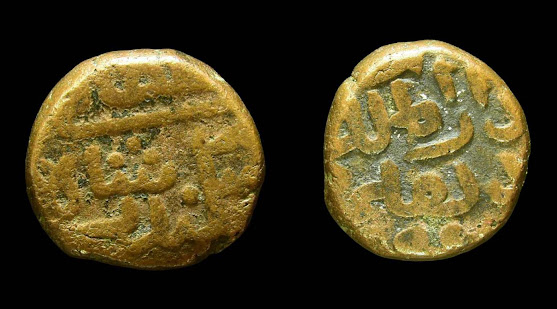Featured
- Get link
- X
- Other Apps
Alauddin Khalji (19 July 1296–4 January 1316)
The third (actually second if we do not consider the usurper Rukn-al-din Ibrahim) and the most powerful sultan of Khalji dynasty was Alauddin Khalji (1296–1316). My earlier posts discussed how he became the sultan by killing his uncle (Jalal-ud-din Khalji) and taking his cousins prisoners.
After he became sultan, the biggest challenge came before his was the periodic raids of the Mongols. He resisted the invasions of the Chagatai Khanate Mongols in Sindh and Punjab, and once even in Dehli, when they besieged Delhi for over two months, and ransacked its suburbs. Finally, in 1306, his forces achieved a decisive victory against the Mongols near the Ravi riverbank, and in the subsequent years, his forces ransacked the Mongol territories in present-day Afghanistan.
In early 1299, Alauddin sent Ulugh Khan and Nusrat Khan to invade Gujarat, where the Vaghela king Karna offered a weak resistance. Alauddin's army plundered several towns including Somnath, where they desecrated the famous Hindu temple. The Delhi army also captured several people, including the Vaghela queen Kamala Devi and slave Malik Kafur. Malik Kafur later became Alauddin's main general and became very close to him. in 1301, Alauddin invaded Ranthambhor fort and after initial defeats, finaly killed the Chahamana king Hammiradeva in his last stand. inthe next year, he attacked chittor and captured after a 8 month long siege. Alauddin assigned Chittor to his son Khizr Khan but later transferred the governance of Chittor from Khizr Khan to the Chahamana chief Maladeva. At the same time, his army sacked the Kakatiya capital Warangal.
In 1304, Alauddin ordered a second invasion of Gujarat, which resulted in the annexation of the Vaghela kingdom to the Delhi Sultanate. In 1305, he launched an invasion of Malwa in central India, which resulted in the defeat and death of the Paramara king Mahalakadeva.
Around 1308, Alauddin sent Malik Kafur to invade Devagiri, whose king Ramachandra had discontinued the tribute payments promised in 1296, and had granted asylum to the Vaghela king Karna. At Devagiri, Kafur achieved an easy victory, and Ramachandra agreed to become a lifelong vassal of Alauddin. The plunder obtained from Devagiri prompted Alauddin to plan an invasion of the other southern kingdoms, which had accumulated a huge amount of wealth, having been shielded from the foreign armies that had ransacked northern India. In late 1309, he sent Malik Kafur to ransack the Kakatiya capital Warangal. Helped by Ramachandra of Devagiri, Kafur entered the Kakatiya territory in January 1310, ransacking towns and villages on his way to Warangal. After a month-long siege of Warangal, the Kakatiya king Prataparudra agreed to become a tributary of Alauddin, and surrendered a large amount of wealth (possibly including the Koh-i-Noor diamond) to the invaders.
Kafur started his march from Delhi in November 1310, and crossed Deccan in early 1311, supported by Alauddin's tributaries Ramachandra and Prataparudra. Hoysala king Ballala could not put up a strong resistance, and negotiated a truce and became a tributary of Alauddin. Malik Kafur then marched to the Pandya kingdom, where he looted a large number of treasures, elephants and horses.
During these campaigns, there were multiple revolts against Alauddin but were suppressed. The Mongols, who converted to Islam and settled in India plotted to kill Alauddin, but the conspiracy was discovered. Alauddin ordered a massacre of Mongols. According to Ziauddin Barani, 20,000 or 30,000 Mongol men were massacred as a result of Alauddin's orders.
Malik Kafur invaded Devagiri again in 1313, became the governor of Devagiri once they tried to overthrow Alauddin's suzerainty.
Alauddin implemented several reforms to be able to maintain a large army and to weaken those capable of organizing a revolt against him. These reforms were based on his conception of fear and control as the basis of good government as well as his military ambitions: the bulk of the measures were designed to centralise power in his hands. Alauddin eliminated the intermediary Hindu rural chiefs, and started collecting the kharaj directly from the cultivators. By suppressing the local chiefs, Alauddin projected himself as the protector of the weaker section of the rural society. Alauddin implemented price control measures for a wide variety of market goods. As part of his measures to prevent rebellions, Alauddin imposed prohibition and also banned other intoxicants.
Like his predecessors, Alauddin was a Sunni Muslim. His administration persecuted the Ismaili (Shia) minorities. Ziauddin Barani states that Alauddin once thought of establishing a new religion but dropped this idea. At times, he exploited Muslim fanaticism against Hindu chiefs and the treatment of the zimmis. He destroyed several Hindu temples during their military campaigns. But he also compromised with the Hindu chiefs who were willing to accept his suzerainty. He also held discussions with Jain sages and honoured them. In fact
Alauddin minted coins with the legend struck as Sikander Sani. The coin legend (Sikander-e -Sani) translates to 'brilliant victor' in recognition of his military success.
During the last years of his life, he became infatuated with his slave-general Malik Kafur, who became the de facto ruler of the Sultanate. Alauddin sent his wife and two sons, Khizar Khan and Shadi Khan, to jail, because Malik Kafur told him that they were conspiring against him. Alauddin died on the night of 4 January 1316. Barani claims that according to "some people", Kafur murdered him. The next day, Kafur appointed Alauddin's young son Shihabuddin as a puppet monarch.
Popular Posts
Ala ud-din Sikandar Shah Tughlaq (22 January − 8 March 1394)
- Get link
- X
- Other Apps
Mu'izz ud-Din Muhammad bin Sam (AH 589-602 / CE 1193-1206)
- Get link
- X
- Other Apps











Comments
Post a Comment